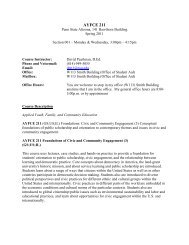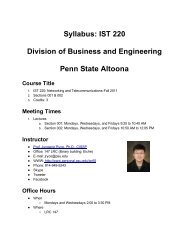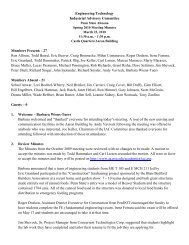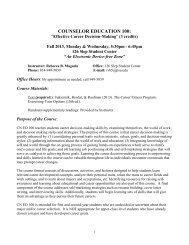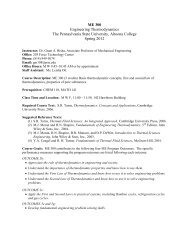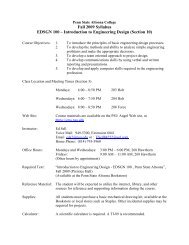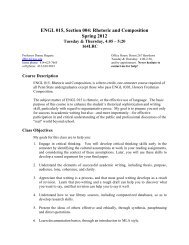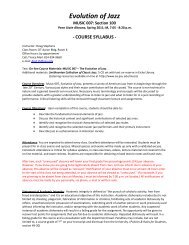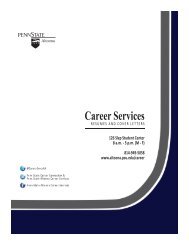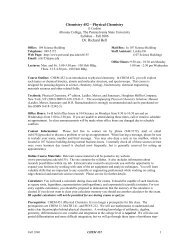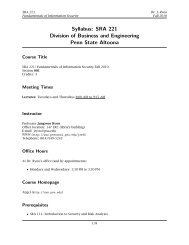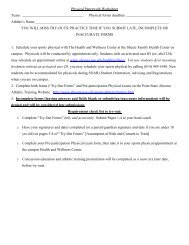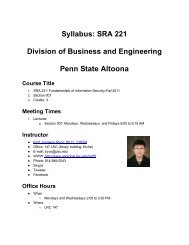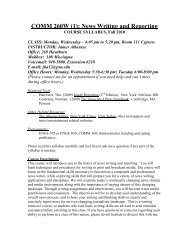ARTH 112 - Penn State Altoona
ARTH 112 - Penn State Altoona
ARTH 112 - Penn State Altoona
Create successful ePaper yourself
Turn your PDF publications into a flip-book with our unique Google optimized e-Paper software.
Art H <strong>112</strong>: Renaissance to Modern Art<br />
Spring 2005 Section 1 MW 4:00:-5:15 117 Science<br />
Section 2 MW 5:30-6:45 117 Science<br />
Instructor: Dr. Jennifer Streb<br />
Office/Voice Mail: 140 Hawthorne, 949-5300, x. 6092<br />
Office Hours: Monday and Wednesday 3:15-3:45 and by appointment<br />
Mailbox: 107 Science<br />
Home Phone: 861-0615 (to be used only in the case of extreme emergencies!)<br />
Email: jls250@psu.edu (this is the best way to reach me)<br />
Course Overview<br />
In this course we will examine the history of painting, sculpture and architecture from the Late<br />
Medieval/Early Renaissance period to the beginning of the 21 st century. This course is intended as a<br />
companion course to Art History 111, which covers Prehistoric to Gothic art. However, each class is<br />
designed to stand alone. Rather than being an inclusive survey of the entire history of art during this<br />
period, the class will focus on a selection of topics representative of major developments. We will attempt<br />
to locate works of art within their historical context. In other words, we will think about the works of art<br />
in terms of contemporary social and political events. We will also attempt to discover who made them and<br />
for what purposes. The objective of the course is to teach students how to think critically about images<br />
and historical information, the foundations upon which the class is built.<br />
Textbook and Course Web Site<br />
Laurie Schneider Adams, Art Across Time: The Fourteenth Century to the Present, Volume 2, 2 nd ed.<br />
The class web site, which can be accessed via www.angel.psu.edu, or www.cms.psu.edu, will be used<br />
primarily as a resource for supplemental images that do not appear in the required textbook and for<br />
contacting the students via email. It is the responsibility of the student to access the site on a regular basis<br />
and to study the images reproduced there. The course syllabus and outlines, study guide, and useful links<br />
to relevant topics are also included. Additionally, as mentioned, the Angel Course Management System<br />
will be used regularly throughout the semester to contact the class via email regarding information about<br />
the exams, quizzes, lecture material etc. It is your responsibility to either check the angel site regularly for<br />
your messages and/or to set up the system so that your messages are forwarded to whatever email account<br />
you use on a daily basis.<br />
The CD-ROM that accompanies the textbook and the student online learning center that is part of the<br />
text’s website (www.mhhe.com/artacrosstime) may also prove useful for students. Although specific<br />
individual assignments probably will not come from either of these sources, students are strongly<br />
encouraged to use both as supplements to the course readings. There are practice multiple choice<br />
questions, essay questions, summaries and outlines on both and many of the web links are quite<br />
interesting and helpful. Additionally, many of the images from the book can be found on the text’s<br />
website by going to the Student Learning Center link, clicking on the particular chapter and then clicking<br />
on “web links.” Many students in the past have used these links and printed out images to study for<br />
quizzes and exams.<br />
ArtH<strong>112</strong>, Sp.05--1
Course Grade<br />
Your final course grade will be computed in the following manner:<br />
Attendance 10%<br />
3 Slide Quizzes 30% (10% each)<br />
Exam 1 15%<br />
Exam 2 20%<br />
Final Exam 25%<br />
Breakdown of material to be covered:<br />
1 st third of the course: Proto Renaissance to Northern Baroque<br />
2 nd third of the course: French Baroque to Realism or Impressionism<br />
last third of the course: Impressionism to Pluralism<br />
Course Calendar<br />
Quiz 1 Wednesday, February 9<br />
Exam 1 Monday, February 14<br />
Quiz 2 Wednesday, March 23<br />
Exam 2 Monday, March 28<br />
Quiz 3 Wednesday, April 27<br />
Final Exam Monday, May 2, 6:00-7:50, 117 Science<br />
Add Drop Deadline—Wednesday January 19<br />
Agreement form handed in no later than Monday January 4<br />
Spring Break (no class)—Monday, March 7 & Wednesday, March 9<br />
Conflict Filing Period—March 21 – April 8<br />
Late Drop Deadline—Friday, April 8<br />
Withdrawal Deadline—Friday, April 29<br />
Attendance<br />
The correlation between poor attendance and poor grades has been demonstrated time and time again. To<br />
encourage attendance, it will count for a percentage of your grade. Each day after the add/drop deadline<br />
(Jan. 19), a sheet with the names of all individuals enrolled in the course will be passed around the room.<br />
Be certain that you sign your name, as this will be evidence of coming to class. It is important that when<br />
you come to class you pay attention to the lectures; your attendance will not be counted if you come to<br />
class just to fall asleep. You will be granted two absences regardless of reason before points are deducted<br />
from your attendance grade.<br />
Punctual attendance for class is expected: students arriving late or leaving early are disruptive not only for<br />
the instructor but for the rest of the students in the class as well. Class will begin at 4:00 and 5:30<br />
respectively. Three late arrivals to class will count as one absence, thereby having an adverse affect on<br />
your attendance grade. If you have a legitimate reason for coming in a few minutes late, please let me<br />
know as soon as possible so points will not be deducted from your grade. Conversely, the classes will end<br />
at 5:15 and 6:45 respectively. It’s rare that I will ever need to hold the class beyond the allotted 75 minute<br />
period. Therefore, please do not begin packing up your bags and putting on your coats (and thus<br />
disturbing those sitting around you) until the class period is over. This too could have an adverse affect on<br />
your attendance grade.<br />
Slide Quizzes<br />
ArtH<strong>112</strong>, Sp.05--2
The slide quizzes will be for the first ten minutes of class on the dates listed above. You will be shown 10<br />
images (for approximately one minute each) and will have to identify the following four characteristics of<br />
each image:<br />
• Artist/Architect’s Name—or “anonymous” if unknown<br />
• Title of the work (if the monument is a building you must also include location (city<br />
and country)!)<br />
• Date (within 10 years on either side of the date or dates provided to you)<br />
• Style (The style is either indicated either by the section headings on the outlines or<br />
within the brackets after the title and date of the work where applicable.)<br />
A study guide with useful study tips can be found on the Angel site. It is your responsibility to download<br />
and read this study guide well in advance of the first quiz; we will not go over the specifics in class, but it<br />
will be to your benefit to read over the guide. The images for these quizzes will be drawn from the class<br />
outlines, and will be the paintings, sculptures and architectural monuments covered in class.<br />
Exams<br />
All three exams will consist of 30 multiple choice questions. Information for these questions will come<br />
from the textbook, outlines, videos, and class lecture material.<br />
THERE WILL BE NO MAKE UP EXAMS OR QUIZZES GIVEN unless circumstances are deemed to<br />
be appropriate by the instructor and an excuse has been provided prior to the exam/quiz. Should a true<br />
emergency arise on the day of an exam/quiz, you must contact the instructor (either by email or by phone)<br />
no later than the class period following the exam/quiz and an official written excuse for your absence will<br />
be required. Any makeup exams given will follow a completely different format from the in class exam<br />
and will most likely be essay exams. The exact format will be discussed upon scheduling.<br />
Class Cancellation Policy<br />
On occasion class may have to be cancelled due to illness or weather. Since our classes meet late in the<br />
day, if it is snowing early in the morning, a decision will not be made by the instructor until early<br />
afternoon (unless, of course, the University decides to shut down). Should class be cancelled, an email<br />
will be sent to all students via Angel and the cancellation will be posted on the <strong>Penn</strong> <strong>State</strong> <strong>Altoona</strong><br />
webpage. In the event that campus closes or class is cancelled on the day of an exam or quiz, the quiz<br />
and/or exam will be pushed back by one class period. For example, if we don’t have class on a<br />
Wednesday quiz day, the quiz will be the following Monday and the exam will be on the Wednesday of<br />
that same week. If campus is closed on a Monday exam day, the exam will be the next class period<br />
(Wednesday).<br />
Outlines, Reading Assignments and Images<br />
Attached you will find outlines listing the works of art and architecture and terms to be covered in class.<br />
As you will notice, not everything covered in the text will be discussed in class. In addition, it is possible<br />
that we will either add monuments/terms or that some of the objects (and/or terms) on the outlines will<br />
not be covered—we will adjust them accordingly depending on time constraints. Nonetheless, the outlines<br />
are meant to serve as a general guide for you as you prepare for each class and will provide you with the<br />
proper spellings of names, monuments and terms during lectures; in other words, be sure to bring your<br />
outlines to class with you each day.<br />
ArtH<strong>112</strong>, Sp.05--3
The works of art for which you will be responsible on the exams are listed on the outlines. The images<br />
found in Art Across Time are noted with the figure number (as in 23.15, meaning chapter 23 image<br />
number 15). In addition, as previously mentioned, we will be using the Angel web site for supplemental<br />
images not reproduced in the text and those are indicated with a W (meaning Web) on the outline.<br />
It is essential that you study the assigned images (and terms) frequently. Waiting until the night before the<br />
quiz or exam to start studying is not recommended. Studying for an hour or two each week will be much<br />
more beneficial in the long run than trying to cram during the 8 hours prior to an exam.<br />
The reading assignments for the course will come from your required text and will follow the outlines.<br />
The corresponding page numbers in the text are provided for you on the outlines. Students are expected to<br />
read all portions of the required text specified on the outlines, and should complete the readings prior to<br />
coming to class each day as a means of acquiring important background for understanding the lectures.<br />
The text book provides useful information, some of which will not be presented in class, and as such, a<br />
complete understanding of the lecture is aided by a familiarity with the reading assignments. Having<br />
already read about the material to be covered each day will also facilitate discussions and will make your<br />
note-taking during class a bit easier.<br />
We may also devote portions of certain class days to watching videos—either entire programs or clips<br />
devoted to a specific monument we’re looking at that day. I recommend taking notes during these videos<br />
because, as stated earlier, exam questions could well come from that material.<br />
Academic Integrity<br />
Cheating will not be tolerated under any circumstances and will result in a zero for the test, quiz or<br />
assignment and could result in failure of the course.<br />
According to the <strong>Altoona</strong> College Academic Integrity Policy:<br />
Academic integrity is the pursuit of scholarly activity in an open, honest and responsible manner.<br />
Academic integrity is a basic guiding principle for all academic activity at The <strong>Penn</strong>sylvania <strong>State</strong><br />
University, and all members of the University community are expected to act in accordance with this<br />
principle. Consistent with this expectation, the University's Code of Conduct states that all students<br />
should act with personal integrity, respect other students' dignity, rights and property, and help create and<br />
maintain an environment in which all can succeed through the fruits of their efforts.<br />
Academic integrity includes a commitment not to engage in or tolerate acts of falsification,<br />
misrepresentation or deception. Such acts of dishonesty violate the fundamental ethical principles of the<br />
University community and compromise the worth of work completed by others.<br />
Student Responsibilities<br />
As stated above, regular class attendance is expected and necessary for a proper understanding of the<br />
course material. Because much of the material for which you are responsible will be covered only in<br />
lectures, it is imperative that you attend class regularly and keep up with the lecture notes and the images<br />
in your book and on the web. Between lectures, the text, videos and the website, you have all the<br />
resources/information you need to do well in here. The rest is up to you, and a large part of doing well in<br />
this course comes down to a certain amount of personal responsibility. We will cover a large amount of<br />
material each day in lecture, and should you miss class for any reason, you are responsible for getting the<br />
notes from a colleague in the class. After receiving those notes, feel free to contact me with any questions<br />
about the material, and I’ll be happy to meet with you.<br />
ArtH<strong>112</strong>, Sp.05--4
Additionally, you are responsible for making sure that you are receiving all of the emails regarding the<br />
class that will be sent out via the Angel system. Much of the information sent out via email will not be<br />
discussed in class, so you need to be sure that you are getting the information.<br />
Because the exams/quizzes will be different for each section, you must take all exams/quizzes with the<br />
section in which you are registered. If you take an exam or quiz with the other section (without prior<br />
approval from the instructor at least one class period before the exam) your grade will not be counted and<br />
you will receive a zero. There will be no exceptions for this.<br />
Courtesy and civility are expected of all students. Talking to your neighbors and disrupting class with any<br />
kind of obscene, sarcastic and/or disrespectful speech often has a negative impact on the learning<br />
environment within the classroom. If you have a question about the lecture or missed something that was<br />
said by the instructor, please raise your hand. Questions are always encouraged in this class. If a student<br />
continues to be disruptive or disrespectful to the instructor and/or other students, however, he/she will be<br />
asked to leave and will risk failing the course.<br />
You are also required to read over this syllabus outside of class within the first several days of the<br />
semester. After doing so, you need to sign the agreement form that appears on the last page of this packet<br />
and return it to the instructor no later than Monday January 24.<br />
If you have any special needs or know of any circumstances that may affect your performance in the<br />
class, please talk to the instructor as soon as possible.<br />
Reserve Reading List<br />
The following books can be found on reserve in the library for your consultation:<br />
Adams, Laurie Schneider, Art Across Time, volumes 1 and 2, N5300.A3 1999<br />
Gardner, ed., Art Through the Ages, 10 th edition, N5300.G25 1996<br />
Janson, H.W., History of Art, volumes 1 and 2, N5300.J3 1995b<br />
Stoksdad, Marilyn, Art History, volumes 1 and 2, N5300.S923.1999<br />
ArtH<strong>112</strong>, Sp.05--5
AH <strong>112</strong> Outline 1 Spring 2005<br />
Begin by reading the Introduction to your text<br />
Proto-Renaissance (pages 465-479)<br />
Nicola Pisano: Nativity, 1259-60 12.2<br />
Cimabue: Madonna Enthroned, 1280-90 12.3<br />
Giotto: Madonna Enthroned, c. 1310 12.4<br />
Giotto: Arena Chapel (Padua, Italy), 1303-1305<br />
Lamentation W<br />
Last Judgment 12.9<br />
TERMS: Humanism, relief, continuous narrative, tempera, Vasari, fresco secco, buon fresco, giornata,<br />
chiaroscuro, grisailles<br />
The Early Renaissance and the Art of Perspective (pages 498-546)<br />
Filippo Brunelleschi: Dome of Florence Cathedral (Florence, Italy), 1420-36 13.4, 13.6<br />
Leon Battista Alberti: Palazzo Rucellai (Florence, Italy), 1450s 13.32<br />
Masaccio: The Holy Trinity, 1425 13.21<br />
The Tribute Money, late 1420s 13.24<br />
Brunelleschi: Sacrifice of Isaac, 1401-02 13.2<br />
Ghiberti: Sacrifice of Isaac, 1401-02 13.2<br />
Lorenzo Ghiberti: The Meeting of Solomon and Sheba, 1424-52 13.16<br />
Fra Angelico: Annunciation, c. 1440 13.48<br />
Donatello: St. Mark, 1411-15 13.29<br />
David, 1430-40 13.30<br />
Andrea Mantegna: Ceiling Tondo of the Camera degli Sposi, 1474 13.56<br />
Dead Christ, 1500 13.15<br />
Botticelli: The Birth of Venus, 1482 13.59<br />
TERMS: Della Pittura, Vitruvius, one point perspective, orthogonals, vanishing point, transversals,<br />
diminution, aerial/atmospheric perspective, typology, contrapposto, foreshortening, relief, Venus Pudica<br />
Northern Renaissance (pages 491-494, 549-557, 628-629 and 638-644)<br />
Limbourg Brothers: Trés Riches Heures du Duc de Berry, January, 1413-16 12.27<br />
Robert Campin: The Merode Altarpiece, 1425-30 13.62<br />
Jan van Eyck: The Arnolfini Wedding Portrait, 1434 13.69<br />
Albrecht Dürer: The Four Horsemen of the Apocalpyse, 1497-98 16.13<br />
Matthias Grünewald: Isenheim Altarpiece, 1510-15 16.16, 16.17, 16.18<br />
TERMS: Book of Hours, triptych, intuitive perspective, disguised symbolism, oil, iconography, woodcut,<br />
polyptych<br />
The High Renaissance in Italy (pages 565-593 and 599-605 )<br />
Donato Bramante: Tempietto, S. Pietro in Montorio (Rome, Italy), 1502-03 14.3, 14.4<br />
Leonardo da Vinci: The Last Supper, 1495-98 14.14<br />
Michelangelo: David, 1501-04 14.19<br />
Sistine Ceiling 14.21, 14.22<br />
Creation of Adam, 1508-12 14.25<br />
Raphael: The School of Athens, 1509-11 14.36, 14.37, 14.39<br />
Giorgione: Sleeping Venus, 1509 [Venetian Renaissance] 14.49<br />
Titian: Venus of Urbino, 1538 [Venetian Renaissance] 14.53<br />
TERMS: Julius II, Martyrium, centralized plan, pyramidal composition, sfumato, Neoplatonism, putti,<br />
ignudi, naked vs. nude<br />
ArtH<strong>112</strong>, Sp.05--6
AH <strong>112</strong> Outline 2 Spring 2005<br />
Mannerism and the Late 16 th Century (pages 585-587, 607-613 and 616-624)<br />
Michelangelo: The Last Judgment, 1534-41 [Mannerism] 14.28<br />
Parmigianino: Madonna and Child with Angels (Madonna of the Long Neck), 1535 [Mannerism] 15.3<br />
Agnolo Bronzino: Allegory: Venus, Cupid, Folly, and Time, 1545 [Mannerism] 15.4<br />
Giulio Romano: Palazzo del Tè (Mantua, Italy), 1525-35 [Mannerism] 15.13, 15.14, 15.15<br />
El Greco: The Burial of Count Orgaz, 1586 [16 th Century] W<br />
Sofonisba Anguissola: The Artist’s Sister Minerva, c. 1559 [16 th Century] 15.11<br />
Palladio: Villa Rotunda (Vicenza, Italy), 1567-69 [16 th Century] 15.19, 15.20<br />
TERMS: Maniera, Martin Luther, Reformation, figura serpentinata<br />
Italian and Spanish Baroque (pages 650-659, 666-679, and 698-701)<br />
Gian Lorenzo Bernini: David, 1623 17.19<br />
Ecstasy of St. Teresa, 1645-52 17.20, 17.21<br />
Francesco Borromini: Façade of San Carlo alle Quattro Fontane (Rome, Italy), 1665-57 17.4, 17.5<br />
Annibale Carracci: Grand Gallery of the Farnese Palace (Rome, Italy), 1597-1601 17.22<br />
Pietro da Cortona: Glorification and Reign of Urban VIII, 1633-39 17.24<br />
Caravaggio: The Calling of St. Matthew, 1599-1600 17.28<br />
Artemisia Gentileschi: Judith Slaying Holofernes, 1614-20 17.30<br />
Artemisia Gentileschi, Judith and Her Maidservant with the Head of Holofernes, c. 1625 17.31<br />
Diego Velázquez: Las Meninas/The Maids of Honor, 1656 [Spanish Baroque] 17.54<br />
TERMS: Counter Reformation, Wölfflin, linear/painterly, planar/recession, closed/open, absolute/relative<br />
clarity, multiplicity/unity, quadro riportato, tenebrism<br />
Northern Baroque (pages 664-665, 680-694)<br />
Peter Paul Rubens: The Elevation of the Cross, 1610 17.34<br />
Anthony van Dyck: Charles I on Horseback, 1638 17.35<br />
Clara Peeters, Still Life with a Vase of Flowers, Goblets and Shells, 1612 W<br />
Franz Hals, The Laughing Cavalier, 1624 17.44<br />
Judith Leyster: Self Portrait at the Easel, c. 1635 W<br />
Rembrandt van Rijn: Self-Portrait Leaning on a Sill (aged thirty-four), 1640 17.39<br />
The Militia Company of Captain Frans Banning Cocq/The Night Watch, 1642 17.38<br />
Jan Vermeer: Woman Holding a Balance, 1664 W<br />
View of Delft, 1660-61 17.47<br />
TERMS: Impasto<br />
French Baroque (pages 660-663 and 702-704)<br />
Georges de la Tour: Joseph the Carpenter, 1645 W<br />
Palace of Versailles (Versailles, France): 17.12<br />
Jules Hardouin-Mansart and Charles LeBrun, Hall of Mirrors, (Versailles, France)1680 17.14<br />
Andre le Notre, Gardens and Park, 1661-68 W<br />
Nicholas Poussin: The Ashes of Phocion,, 1648 17.56<br />
TERMS: Jean Colbert, Charles le Brun, Royal Academy of Painting and Sculpture, stoic philosophy<br />
ArtH<strong>112</strong>, Sp.05--7
AH <strong>112</strong> Outline 3 Spring 2005<br />
Rococo and the 18 th Century (pages 706-723)<br />
Germain Boffrand: Hotel de Soubise, Salon de la Princesse (Paris, France), 1737-40 [Rococo] 18.2<br />
Antoine Watteau: Pilgrimage to Cythera, 1717 [Rococo] 18.4<br />
Jean-Honoré Fragonard: The Swing, 1766 [Rococo] 18.7<br />
Hyacinthe Rigaud: Louis XIV, 1701 [18 th C] 18.8<br />
Rosalba Carriera: Louis XV, 1721 [Rococo] 18.9<br />
Élisabeth Vigée-Lebrun: Marie Antoinette with her Children, 1788 [18 th C] 18.10<br />
Thomas Gainsborough: Mrs. Richard Brinsely Sheridan, 1785-87 [British Rococo] 18.11<br />
William Hogarth: Breakfast Scene from Marriage à la Mode, 1745 [British Rococo] 18.12<br />
TERMS: Rocaille, Rubeniste, Poussiniste, fête galante, pastel, Joshua Reynolds, 15 Discourses, Royal<br />
Academy of Art<br />
Neoclassicism in Europe and America (pages 724-725, 734-744, 728-730 and 745-752)<br />
Richard Boyle, Earl of Burlington: Chiswick House (near London, England), 1725 18.20<br />
Angelica Kauffmann: Cornelia Pointing to Her Children as Her Treasure, 1785 W<br />
Jacques-Louis David: The Oath of the Horatii, 1784-85 19.3<br />
The Death of Marat, 1793 19.5<br />
Napoleon Crossing Saint Bernard Pass, 1800 19.6<br />
Jean-Auguste-Dominique Ingres: Napoleon Enthroned, 1806 19.12<br />
Grande Odalisque, 1814 19.14<br />
Pierre Vignon: La Madeleine (Paris, France), 1807-36 W<br />
Jean-Francois-Thérèse Chalgrin et al.: Arc de Triomphe (Paris, France), 1806-36 19.7<br />
Rude: Departure of the Volunteers of 1792, 1833-36 20.4<br />
John Singleton Copley: Paul Revere, 1768-70 18.27<br />
Benjamin West: Death of General Wolfe, 1770 18.28<br />
Thomas Jefferson: Virginia <strong>State</strong> Capitol (Richmond, VA), 1785-89 19.17<br />
Monticello (Charlottesville, VA), 1769-84 19.16, 19.18<br />
Rotunda of the University of Virginia (Charlottesville, VA), 1817-26 19.20<br />
Horatio Greenough: George Washington, 1832-41 19.22<br />
Edmonia Lewis: Forever Free, 1867 W<br />
TERMS: Locke, Winkelmann, Exemplum virtutis, Prix de Rome, Jacobins, oda, odalisque, Federal Style,<br />
Age of Enlightenment<br />
Romanticism in Europe and America (pages 725-26, 753-776)<br />
Horace Walpole: Strawberry Hill (Twickenham, England), 1749-77 18.23<br />
Charles Barry and A.W.N. Pugin: Houses of Parliament (London, England), 1836-70 20.1<br />
Théodore Géricault, The Raft of the Medusa, 1819 20.8<br />
Eugène Delacroix: Death of Sardanapalus, 1826 20.11<br />
Liberty Leading the People, 1830 20.12<br />
Francisco de Goya: The Executions of the Third of May 1808, 1814 20.18<br />
Caspar David Friedrich: Abbey in an Oak Forest, 1809-10 W<br />
John Constable: The Haywain, 1821 W<br />
J.M.W. Turner: The Burning of the Houses of Lords and Commons, October 16, 1834, 1835 20.22<br />
Thomas Cole: View from Mount Holyoke, Northampton, MA, after a Thunderstorm<br />
(The Oxbow), 1836 20.23<br />
TERMS: J. Rousseau, I. Kant, E. Burke, sublime, Salon, July Revolution, Hudson River School<br />
ArtH<strong>112</strong>, Sp.05--8
AH <strong>112</strong> Outline 4 Spring 2005<br />
Early Photography (pages 786-791)<br />
Joseph Nicéphore Niépce: View from His Window at Le Gras, 1826 21.10<br />
Louis Jacques Daguerre: The Artist’s Studio, 1837 W<br />
Boulevard du Temple, Paris, 1838 W<br />
William Henry Fox Talbot: Lace, 1844 W<br />
The Open Doory, 1843 W<br />
Oscar Rejlander: The Two Ways of Life, 1857 W<br />
Nadar: Sarah Bernhardt, c. 1864 22.12<br />
Julia Margaret Cameron: Mrs. Herbert Duckworth, 1867 21.14<br />
TERMS: Positivism, camera obscura, Johann Schulze, bitumen of Judea, heliograph, latent image,<br />
daguerreotype, photogenic drawing, calotype, Pencil of Nature, composite printing, Baudelaire, Ruskin,<br />
positivism, composite printing<br />
Nineteenth-Century Realism in Europe and America (pages 777-785 and 794-798)<br />
Rosa Bonheur: Plowing in the Nivernais/The Dressing of the Vines, 1849 W<br />
Gustave Courbet: The Stonebreakers, 1849 21.3<br />
Honoré Daumier: Third-Class Carriage, c. 1862 21.5<br />
Édouard Manet: Le Déjeuner sur l’Herbe, 1863 21.23<br />
Olympia, 1863 21.24<br />
Thomas Eakins: The Gross Clinic, 1875-76 21.20<br />
Henry O. Tanner: The Banjo Lesson, 1893 W<br />
TERMS: Bourgeoisie, Darwin, avant garde, Marx, Engels, Communist Manifesto, Salon des Refusées,<br />
Baudelaire, lithography<br />
French Impressionism (pages 805-831)<br />
Édouard Manet: A Bar at the Folies-Bergère, 1881-82 22.7<br />
Claude Monet: Impression Sunrise, 1872 W<br />
Rouen Cathedral, 1894 22.19, 22.20<br />
Waterlilly Pond, 1904 22.18<br />
Edgar Degas: L’Absinthe, 1876 22.9<br />
The Dancing Lesson, 1883-85 22.11<br />
Auguste Renoir: Le Moulin de la Galette, 1876 22.8<br />
Mary Cassatt: The Boating Party, 1893-4 22.14<br />
Berthe Morisot: The Cradle, 1873 22.16<br />
TERMS: Chevreul, plein air, optical mixing, Société Anonyme, Japonisme<br />
Post Impressionism (pages 838-857)<br />
Paul Cézanne: Still Life with Apples, 1875-7 23.5<br />
Georges Seurat: Sunday Afternoon on the Island of La Grande Jatte, 1884-86 23.8<br />
Vincent van Gogh: The Night Café, 1888 W<br />
Paul Gaugin: Where do we come from? What are we? Where are we going?, 1897 W<br />
The Vision After the Sermon (Jacob Wrestling with the Angel), 1888 W<br />
Edvard Munch: The Scream, 1893 23.27<br />
TERMS: Divisionism/Pointillism, synthetism, cloisonnism, arbitrary/non-local color<br />
ArtH<strong>112</strong>, Sp.05--9
AH <strong>112</strong> Outline 5 Spring 2005<br />
Matisse and Picasso (pages 868-875, 881-882, 887-895)<br />
Henri Matisse: Madame Matisse (The Green Line), 1905 [Fauvism] 24.3<br />
Harmony in Red, 1908-9 [Post-Fauvism] 24.12<br />
Pablo Picasso: Les Desmoiselles d’Avignon, 1907 [Analytic Cubism] 25.2<br />
Three Musicians, 1921 [Synthetic Cubism] 25.10<br />
TERMS: Fauvism, Salon d’Automne, Analytic Cubism, Synthetic Cubism, Collage, Simultaneity,<br />
Abstract vs. non-objective<br />
Expressionism and Abstraction (pages 876-880, 901-902, 898)<br />
Vassily Kandinsky: Painting Number 201, 1914 [Expressionism, The Blue Rider] 24.8<br />
Franz Marc: The Large Blue Horses, 1911 [Expressionism, The Blue Rider] 24.10<br />
Ernst Ludwig Kirchner: Five Women in the Street, 1913 [Expressionism, The Bridge] 24.5<br />
Kasimir Malevich: Suprematist Composition: White on White, 1918 [Suprematism] W<br />
Piet Mondrian: Composition in Blue, Yellow and Black, 1936 [de Stijl] W<br />
TERMS: Concerning the Spiritual in Art, Der Blaue Reiter, Die Brücke, Worringer, Suprematism, de Stijl<br />
Art for Art’s Sake and American Abstraction (pages 833-36, 899-900, 937-941)<br />
J.A.M. Whistler: Nocturne in Black and Gold: The Falling Rocket, 1875 22.31<br />
Marcel Duchamp: Nude Descending a Staircase, No. 2, 1912 [Cubo-Futurism] 25.18<br />
Arthur Dove: Nature Symbolized, 1911-14 [American Abstraction] W<br />
Georgia O’Keeffe: Black Iris, 1926 [Early Modernism] W<br />
TERMS: Armory Show, cubo-futurism, extractions<br />
Dada and Surrealism (pages 914-924)<br />
Marcel Duchamp: Fountain, 1917 [Dada] 26.2<br />
L.H.O.O.Q., 1919 [Dada] 26.1<br />
Morton Schamberg: God, 1919 [Dada] W<br />
Joan Miró: Dog Barking at the Moon, 1926 [Surrealism] 26.11<br />
Salvador Dali: The Persistence of Memory, 1931[Surrealism] 26.10<br />
TERMS: Caberet Voltaire, conceptual art, readymades, readymade-aided, André Breton, dream imagery,<br />
psychic automatism<br />
America in the 1930s (pages 900-901, 931-934, )<br />
Charles Sheeler: American Landscape, 1930 [Precisionism] W<br />
Aaron Douglas: From Slavery Through Reconstruction, Aspects of Negro Life, 1934<br />
[Harlem Renaissance] 25.21<br />
James Van Der Zee: Couple in Raccoon Coats, 1932 [Harlem Renaissance] W<br />
Grant Wood: American Gothic, 1930 [Regionalism] 26.22<br />
Edward Hopper: The Night Café, 1942 [American Scene] W<br />
Jacob Lawrence: Harriet Tubman Series, No. 7, 1939-40 [Social Realism] 26.23<br />
Dorthea Lange: Migratory Cotton Picker, Eloy, Arizona, 1940 [Social Realism] 26.28<br />
Isabel Bishop: At the Noon Hour, 1935 [14 th Street School] W<br />
Minna Citron: Hope Springs Eternal/Bargain Basement, 1930s [Social Realism] W<br />
TERMS: Precisionism, Harlem Renaissance, Alain Locke, Regionalism, American Scene, FSA<br />
ArtH<strong>112</strong>, Sp.05--10
AH <strong>112</strong> Outline 6 Spring 2005<br />
Abstract Expressionism: The New York School (pages 944-956, 962 )<br />
Jackson Pollock: Black and White, 1948 W<br />
Willem de Kooning: Woman and Bicycle, 1952-53 27.12<br />
Lee Krasner: Little Image Paintings, 1948 W<br />
Mark Rothko: Green on Blue, 1956 W<br />
Barnett Newman: Vir Heroicus Sublimis, 1950-51 W<br />
David Smith: Cubi XVIII and Cubi XVII, 1963-64 27.26<br />
TERMS: Greenberg, Rosenberg, Action Painting, color field painting<br />
The 1960s and 1970s: Pop, Op, and Minimalism (pages 965-977)<br />
Richard Hamilton: Just What is it that makes today’s homes so different, so appealing?, 1956 [Pop]28.1<br />
Jasper Johns: Three Flags, 1958 [Pop] 28.2<br />
Robert Rauschenberg: Retroactive I, 1964 [Pop] 28.4<br />
Robert Rauschenberg: Oracle W<br />
Andy Warhol: Campbell Soup Can, 1962 [Pop] 28.5<br />
Gold Marilyn, 1962 [Pop] W<br />
Roy Lichtenstein: Little Big Picture, 1965 [Pop] 28.8<br />
Claes Oldenberg, Clothespin, 1976 [Pop] 28.14<br />
Bridget Riley: Aubade (Dawn), 1975 [Op] 28.19<br />
Donald Judd: Untitled, 1988 [Minimalism] 28.20<br />
Dan Flavin: Untitled (in Honor of Harold Joachim), 1977 [Minimalism] 28.21<br />
TERMS: post modernism, Alloway, encaustic, benday dots<br />
Post-Painterly Abstraction (pages 954-)<br />
Helen Frankenthaler: Interior Landscape, 1964 W<br />
Morris Louis: Where, 1960 W<br />
Frank Stella: Die Fahne Hoch, 1959 W<br />
Feminist Art (pages 1008, 1017)<br />
Judy Chicago: The Dinner Party, 1973-79 29.32<br />
Miriam Schapiro: Mary Cassatt and Me, 1976 W<br />
Faith Ringgold: Harlem Renaissance Party Quilt, 1988 W<br />
Barbara Kruger: Untitled (It’s a small world but not if you have to clean it), 1990 W<br />
Cindy Sherman: Untitled film still #35, 1979 W<br />
Guerilla Girls: Do women have to be naked to get into the Met. Museum, 1989 W<br />
TERMS: feminism<br />
Other Trends—Pluralism (pages 990-991, 1002, 1014, 985-987, 1007, 1016)<br />
Bruce Nauman: Self Portrait as Fountain, 1966-67 [Performance] W<br />
Vito Acconci: Seedbed, 1972 [Performance] W<br />
Chris Burden: Trans-fixed, 1974 [Performance] W<br />
Richard Estes: The Solomon R. Guggenheim Museum, 1979 [Super Realism] 29.8<br />
Duane Hanson: Artist With Ladder, 1972 [Super Realism] W<br />
Robert Smithson: Spiral Jetty (Great Salt Lake, Utah), 1970 [Earth Art] 29.23<br />
Maya Lin: Vietnam Veteran’s Memorial (Washington, DC), 1981-83 [Earth Art] 29.40<br />
Robert Mapplethorpe: Nude, 1981 [Photography] W<br />
Andres Serrano: Piss Christ, 1987 [Photography] W<br />
Jean-Michel Basquiat: Carbon/oxygen, 1984 [Graffitti] 29.31<br />
Jeff Koons: New Hoover Convertibles, Green Blue; New Hoover Convertibles, Green<br />
Blue; Double-decker, 1981-87 29.42<br />
TERMS: super realism, NEA<br />
ArtH<strong>112</strong>, Sp.05--11
AH <strong>112</strong> Outline 7 Spring 2005<br />
Nineteenth-Century Architecture (pages 798-804 and 858-859 )<br />
Joseph Paxton: The Crystal Palace (London, England), 1850-51 [Steel] 21.26<br />
John and Washington Roebling: Brooklyn Bridge (New York, NY), 1869-83 [Steel] 21.27<br />
Gustave Eiffel: Eiffel Tower (Paris, France), 1887-80 [Wrought Iron] 21.30<br />
Denkmar Adler/Louis Sullivan: Wainwright Building (St. Louis, MO), 1890-91 [Chicago School] 21.31<br />
Victor Horta: Tassel House (Brussels, Belgium), 1893 [Art Nouveau] 23.30<br />
Early Twentieth-Century Architecture (pages 906-912)<br />
Frank Lloyd Wright: Robie House (Chicago, IL), 1906-1909 [Prairie School]<br />
Fallingwater (Bear Run, PA), 1936 [Organic Architecture]<br />
Gerrit Rietveld: Shroeder House (Utrecht, Netherlands), 1923-24 [De Stijl]<br />
Le Corbusier: Villa Savoye (Poissy-sur-Seine, France), 1928-30 [International Style]<br />
William van Alen: Chrysler Building (New York, NY), 1928-30 [Art Deco]<br />
Mies van der Rohe/Philip Johnson: Seagram Building (New York, NY), 1956-58 [International Style]<br />
Post Modern Architecture (pages 995-1001)<br />
Robert Venturi, Denise Scott Brown: Vanna Venturi House (Chestnut Hill, Pa), 1962<br />
Charles W. Moore and William Hersey, Piazza d’Italia (New Orleans, LA), 1978-79<br />
Michael Graves: Portland Public Services Building (Portland, OR), 1980-82<br />
Richard Rogers: Lloyd’s Building (London, England), 1986<br />
Frank Gehry: Solomon R. Guggenheim Museum Bilbao (Bilbao, Spain), 1993-97<br />
ArtH<strong>112</strong>, Sp.05--12
I hereby acknowledge that I have received and thoroughly read a copy of the syllabus for Art<br />
History <strong>112</strong>. I understand the course requirements as pertaining to attendance, academic<br />
integrity, quizzes, exams, civility, reading assignments and the course website, and I<br />
acknowledge that it is my duty to responsibly keep up with the course materials including<br />
readings, lecture materials and emails. As such, I agree to adhere to the policies for this course as<br />
set forth by the instructor.<br />
___________________________________<br />
Print Name<br />
__________________________________ _______________________<br />
Signature Date<br />
ArtH<strong>112</strong>, Sp.05--13



